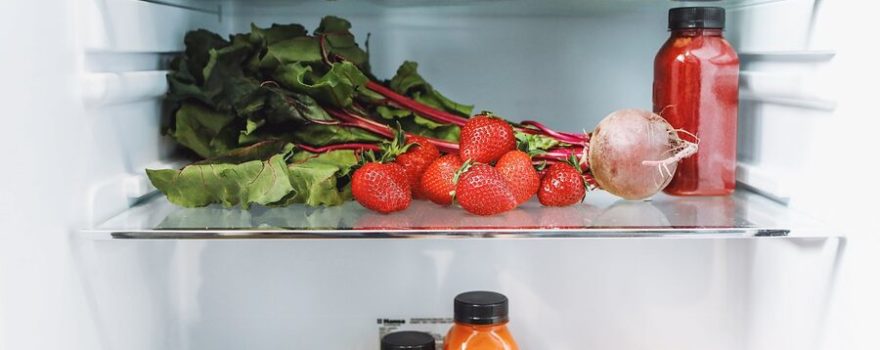
Keeping your refrigerator mould-free will stop you from becoming ill! By properly maintaining your appliance and setting it at the right temperature you’ll be preventing food waste, and saving a great deal of money. Dirt and spillages can affect the fridge temperature by stopping the cold air from circulating. And mould and bacteria can put you at risk.
The inside of your fridge should be regularly cleaned with a warm water and soap solution, rinsed with clean water and dried with paper towels. But what causes mould on the refrigerator door seal? Read on…
Reasons for Black Mould
One of the common causes of black mould and mildew in the gasket is due to cold air escaping from the fridge, and warm kitchen air taking its place. This, in turn, makes the water condense, and causes mould to grow.
Refrigerator Mould Facts
What can mould do to you? This frequently asked question can be answered simply. Mould can be harmful as it not only spoils food but can have a detrimental effect on your health too. Food that has visible mould should be wrapped up and put in the bin. Try to avoid smelling it as you could inhale spores that may lead to an allergic reaction.
Mouldy food in the fridge can lead to the mould growing inside the rubber seals as well as in the fridge interior. Mould spores are spread by contact through surfaces and through the air. Surface mould indicates roots that are invisibly invading, and eating these foods may cause food poisoning or even cancer.
People susceptible to respiratory problems may become sick if mould is ingested.
Remember that some foods have a mould coating such as hard salami, hard cheese, and dry-cured ham. The mould will need to be trimmed off before eating. The knife used should then be washed to prevent any cross-contamination.
Fridge Maintenance to Avoid Mould
Black mould in the refrigerator seal needs to be dealt with immediately, or you may end up having a refrigerator gasket replacement. The gaskets attract mould and mildew so food spillages should be removed as soon as possible. Look at a few simple steps to keep your rubber seals well-maintained:
- Wipe away dirt and residues with warm soapy water.
- Spray an appropriate cleaning agent onto the seal and let it stand for a few minutes.
- Or use a bleach and water mixture to scrub away the visible mould.
- Try using a toothbrush or cotton bud to get into awkward areas.
- Remove the solution with a soft dry cloth.
- After cleaning apply a little vinegar to stop the mould from growing back.
- Keep dishcloths and sponges clean to avoid spreading germs.
Fridge Gasket Functions
A refrigerator gasket commonly known as a refrigerator door seal is a flexible elastic strip that is attached to the outer edge of the fridge or freezer compartment. It’s designed to form an air-tight seal that acts as a barrier between the warm external environmental air, and the cool air inside the fridge.
Seals should be checked annually to ensure they’re in good condition. If the seals become cracked, dry out, or get damaged in any way the fridge is unable to maintain an even temperature as the cold air seeps out. This results in the compressor to run more frequently and wastes electricity.
If the problem isn’t resolved moisture may start to condense on the outside of the fridge with the interior forming ice. Food will spoil quickly as the fridge temperature is too warm.
Keeping Your Fridge Gaskets Mould Free
It’s important to keep your fridge gasket mould free as this is another reason why the fridge will begin to operate ineffectively. What causes mould on the refrigerator door seal is the moisture and lack of ventilation within the fridge itself – this is the ideal breeding ground for toxins that can cause allergic reactions and more serious health issues.
Removing mould from the refrigerator, seals can be done with warm water and baking soda mix. This should be followed by a thorough rinse and a wipe dry with a clean cloth. You can use vinegar as a disinfectant if you prefer, or a simple solution of warm soapy water to clean mould from the refrigerator door seal.
You should avoid products that contain detergent, bleach, or ammonia as they can damage the fridge. Bleach does kill mould but doesn’t penetrate into the rubber so mould spores won’t be eradicated. Bear in mind you can’t put these seals into a dishwasher.
How to clean mould from fridge seals can be done simply by following the guidelines below:
- Empty the fridge
- Put vinegar in a spray bottle
- Spray the gasket
- Leave to stand for 10 minutes
- Wipe off all mould with a clean cloth
- Use an old toothbrush to reach under the seal
- Rinse with clean water
- Leave the door open to let the gasket dry
- Restock the appliance
Preventing Refrigerator Gasket Mould
Now you know how to remove mould from the rubber seal on refrigerator it’s good to know what steps to take to try and prevent it from happening:
- Wipe up any water drips as soon as you see them
- Always keep the fridge plugged in and turned on
- Keep the temperature at the right setting
- Make sure your fridge has enough external ventilation
Replacing Fridge Door Seals
Refrigerator door seal replacement may be necessary if you can’t clean existing ones to your satisfaction or they’re simply worn out and the fridge door won’t stay closed. As these problems can cause your fridge to use much more energy a refrigerator seal replacement is important.
You may be able to fit a fridge door seal replacement yourself if it’s just a simple case of pulling the gasket away from the door. On some models, the seal has to be cut away, and others require removing screws located under the gasket itself.
You’ll need to switch off your appliance at the mains before you start any removal of old seals. Place your thumb gently underneath and run it all around and the seal will easily come away. Start at the top corners when fitting the new seal, pressing firmly to lock into place. Spread out any excess evenly towards the middle until the seal is flush. If you need help with gasket replacements simply call an experienced appliance repair engineer.
Other Refrigerator Door Seal Issues
If your door gasket is sagging and not fitting correctly your fridge has to work harder to stop the cold air from escaping. So:
- Look for any cracks in the rubber which means the seal has dried out.
- If you shut the door with a piece of paper inserted, and then can easily pull the paper out, this may mean the gasket has become misshapen and needs replacing.
- If you can’t easily remove any black mould from your gasket you may need to contact a trusted repair company.
Find a Local Appliance Repair Team
When you need professional help with replacing a mouldy or faulty gasket simply search online. Get a service that gives you a free quote, is carried out by trained and qualified engineers and provides you with a six months part and labour guarantee.
You’ll be able to book a quick and convenient appointment to ensure your fridge is once again keeping your food and you healthy!



